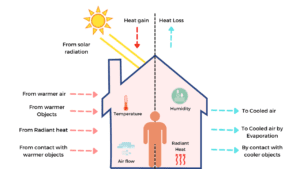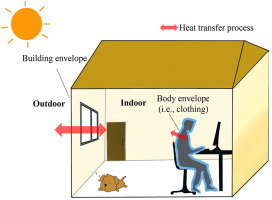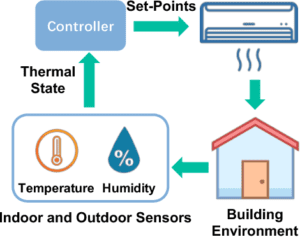Building Colors on Thermal Comfort
- Building color choices can influence thermal comfort in several ways, impacting both energy efficiency and the comfort levels of occupants.
- Here’s a detailed look at how different colors affect thermal comfort:
Heat Absorption and Reflection
- Light Colors: Light-colored exteriors (like white, beige, and pastel shades) reflect a higher percentage of sunlight. This reduces heat absorption, keeping surfaces cooler and indirectly cooling the interior. This effect is particularly beneficial in hot climates, where the goal is to reduce solar heat gain and maintain a cooler interior.
- Dark Colors: Dark colors (such as black, navy, and dark brown) absorb more solar radiation, resulting in higher surface temperatures. This can increase the heat inside the building, which may be desirable in colder climates to reduce heating requirements.

Thermal comfort Design parameter
Thermal Comfort and Interior Temperature
- Buildings with lighter colors can maintain lower indoor temperatures in hot climates, enhancing thermal comfort by reducing the need for air conditioning.
- Dark-colored buildings in cold climates can help capture and retain heat, supporting thermal comfort during colder months without excessive reliance on heating systems.
Impact on Radiant Heat and Surface Temperatures
- Roof Color: Roof color is crucial as roofs receive direct sunlight. Darker roofs can increase radiant heat inside top-floor rooms, affecting comfort levels. Cool-colored roofing materials, including white or reflective coatings, can significantly reduce radiant heat, improving thermal comfort on upper floors.
- Wall Color: External wall colors also influence thermal comfort, especially in rooms exposed to direct sunlight. Lighter wall colors minimize solar heat gain, which can make a noticeable difference in thermal comfort for walls exposed to high levels of sunlight.
Thermal Comfort Perception
- Cool Tones (Blues, Greens): In interiors, cool-toned colors are associated with a refreshing effect, often leading occupants to feel more comfortable at slightly higher temperatures. This psychological effect can reduce cooling needs.
- Warm Tones (Reds, Oranges, Yellows): Warm tones make spaces feel cozier and are psychologically warming. These colors may help occupants feel warmer in cooler temperatures, potentially reducing heating needs.

Energy Efficiency and Cost Implications
- By choosing colors strategically (light for hot climates, dark for cold climates), buildings can maintain thermal comfort passively, which can lead to reduced energy costs for heating or cooling systems.
- In climates with large seasonal temperature variations, incorporating a combination of light and dark elements (e.g., a light roof with darker lower walls) may help balance year-round thermal comfort needs.
Use of Reflective and Cool Paints
- Specialized reflective paints are available that enhance light-colored surfaces’ reflective properties, even in slightly darker shades. These “cool” paints reflect more sunlight, helping buildings stay cooler than traditional paints of the same color, which can further enhance thermal comfort.
Color Guide lines for building for thermal comfort
- Color selection in building design can enhance thermal comfort by affecting heat absorption, reflection, and even the psychological perception of temperature. Here are color guidelines to optimize thermal comfort based on climate, building orientation, and specific building elements:
Climate-Based Color Selection
- Hot Climates: Prioritize light, reflective colors for exterior surfaces, such as white, beige, light gray, and pastel shades. These colors minimize heat absorption, keeping interiors cooler.
- Cold Climates: Use darker, heat-absorbing colors like dark gray, brown, dark blue, and other rich tones on exterior surfaces to retain warmth within the building, helping lower heating costs.
- Mixed/Temperate Climates: Consider using a combination of light and mid-tone colors. Lighter colors for the roof and southern/western walls reduce summer heat gain, while medium tones can provide some warmth retention in winter.
Orientation-Specific Color Choices
- South and West-Facing Walls (high sun exposure in the Northern Hemisphere):
- Use light colors on these walls to reflect intense sunlight and reduce heat buildup.
- In hot climates, reflective paints or coatings can be beneficial here to limit solar heat gain.
- North and East-Facing Walls (less direct sun exposure):
- These walls can use slightly darker shades, as they receive less sunlight and thus absorb less heat.
- In cooler climates, warmer tones on these walls can help absorb indirect sunlight to contribute to passive heating.

Roof Color for Thermal Comfort
- Light-Colored Roofs: Use white or cool roofing materials in hot climates to reflect solar radiation and reduce indoor temperatures. Specialized reflective coatings are available for roofs to enhance thermal comfort.
- Darker Roofs: In cold climates, darker roof colors can retain heat, reducing energy needed for interior heating.
- Green Roofs: Vegetative or green roofs can be highly effective in moderating temperature, providing natural insulation in both hot and cold climates.
Interior Color Psychology for Thermal Perception
- Cool Tones (Blues, Greens): These colors give a refreshing feel, suitable for hot climates. They can make occupants feel cooler, possibly reducing the need for active cooling.
- Warm Tones (Reds, Oranges, Yellows): These colors provide a sense of warmth, which is beneficial in cold climates, as they can help occupants feel warmer and reduce heating needs.
- Neutral Tones (Beige, Light Gray): Neutrals are versatile and generally suitable for all climates. They can contribute to a calm atmosphere without strongly affecting perceived temperature.
Use of Reflective and Cool Paints
- Cool Roof Coatings: Use specialized cool coatings on rooftops to reflect solar radiation, particularly in hot and sunny climates. These coatings are available in various colors, including lighter shades, and can significantly reduce surface temperatures.
- Reflective Exterior Paints: Reflective paints with infrared-reflecting pigments are available in a range of colors. These can keep buildings cooler even in medium or darker shades, allowing for more design flexibility without compromising thermal comfort.
Color Choices for Windows and Shading Elements
- Window Frames: Use lighter colors on frames in sun-exposed areas to reduce heat absorption. Darker frames may be beneficial in shaded areas.
- Shading Devices (Awnings, Shutters): In hot climates, use light-colored or reflective materials to deflect sunlight, keeping interiors cooler. Darker colors can be used in colder climates for shutters and shades to absorb sunlight when closed.
Seasonal Considerations for Mixed Use
- Multi-Color Strategy: For buildings in regions with large seasonal temperature swings, consider using a multi-color scheme, with lighter shades on highly sun-exposed surfaces and medium tones in shaded or less exposed areas. This approach balances both summer cooling and winter warming needs.
- Interior Seasonal Flexibility: Consider warm-toned decor (e.g., rugs, curtains) for winter months and cooler-toned accents for summer. This can enhance psychological comfort without changing the primary color scheme.
Sustainable and Energy-Efficient Choices
- Opt for eco-friendly, non-toxic paints that contribute to a healthy indoor environment.
- Use color choices strategically to maximize natural light, reducing artificial lighting needs.

Summary
- Building color plays a significant role in influencing indoor temperatures and occupant comfort, especially in areas with extreme climates.
- Light colors are effective for reducing heat gain and maintaining coolness in hot climates, while dark colors can enhance heat absorption, beneficial in colder climates.
- By strategically choosing colors based on the building’s location, orientation, and climate, designers can enhance thermal comfort while reducing energy consumption.
- By aligning building colors with climate, orientation, and material reflectivity, designers and homeowners can significantly improve thermal comfort and reduce energy demands.
- These guidelines can serve as a framework for making color choices that enhance both comfort and sustainability.

